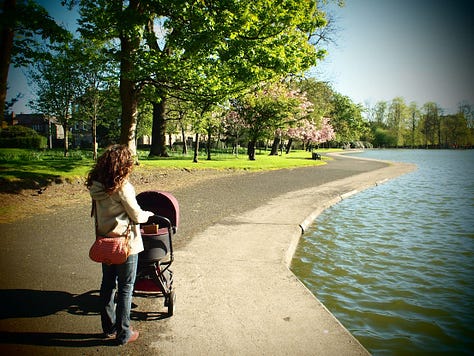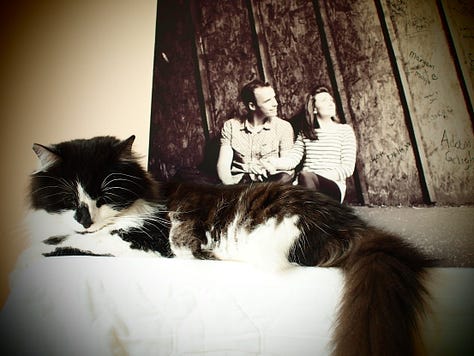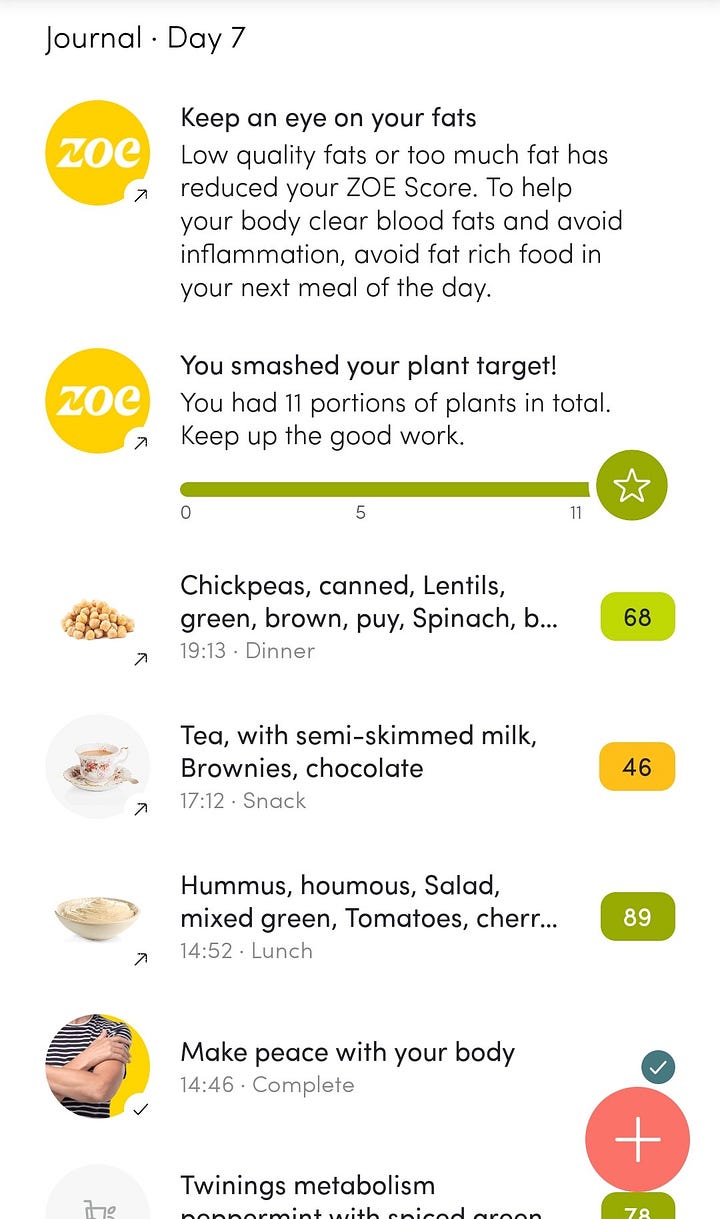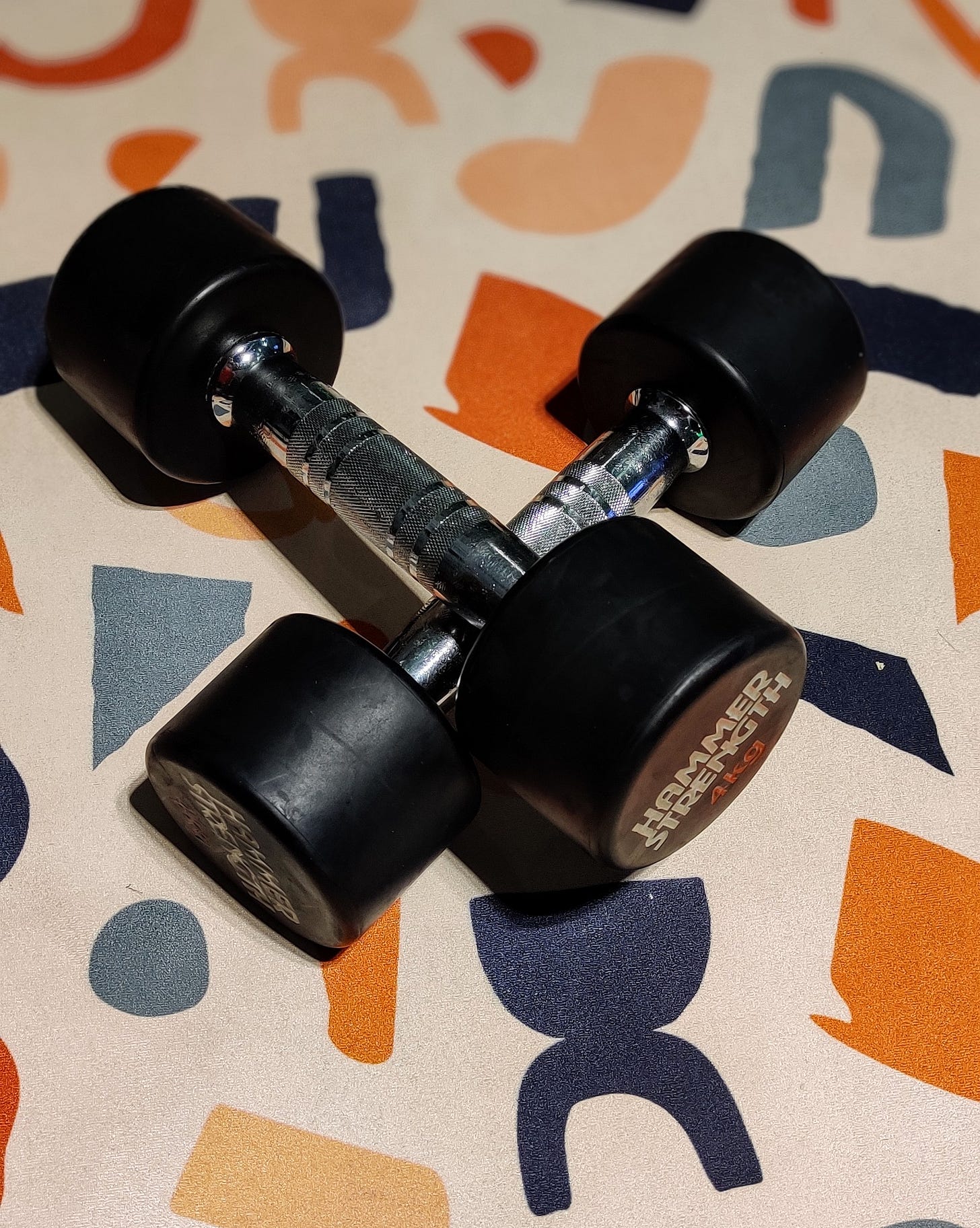Hello! This fortnight, I'm experimenting with the Substack voiceover feature but I'm not entirely happy with the quality of the sound when I'm listening through my headphones despite recording in various programmes, rooms and on three different mics… Nearly-but-not-quite will have to do for this week. It does sound good on a speaker though, so blast it loud. Offer your counsel in the comments!
I turn 40 in a fortnight and I’m delighted to report there’s been little in the way of angst about this upcoming milestone. Far less than when I was staring the last round number in the face, anyway. Between the significant birthdays of 21 and 30, I’d ‘achieved’ much of what dominant culture deems we should. I’d met the person I would later marry; got my Big D (thanks, Wet Leg. We used to call it a first-class honours degree but I like this); got a permanent teaching job; bought a flat. And then things really rattled on a-pace. In the space of 18 months we got a cat, got married, had a baby and bought a big old house in the southside of Glasgow to renovate. Oh, it was all going so well. Well, as far as my smug Instagram feed reported. Indeed, around that time my brother sent me a text in error destined for his girlfriend which read: CATHOUSEBABYCATHOUSEBABYCATHOUSEBABY. (He may have muted my feed soon after.)



However I chose to present my life, it was around 30 that I came to accept that my mental health hadn’t been great for quite a while. There was a feeling I struggled to articulate which I now remember as like being shunted, unprepared, into a life I didn’t know how to live. Who was I, now? Concurrently, I’d started having panic attacks; the physical aspects of which had me convinced there was something gravely wrong with me. In private, I would clutch at anything if it promised solace or salve. Teas, tinctures, supplements… The list goes on. I’d convince myself my interventions were working, only for the sheen to rub off after a while, throwing me back to square one. It would take the guts of a decade - and three years of intensive talking therapy, plus meds - for it to begin to make sense to me. I craved stability and when that was threatened (even by good stuff), I struggled to cope. Too much change. Even good change, it seems, can be hazardous for some of us.
Thankfully this post isn’t about that time. It is about now. A more authentic, slower ‘now’ that is open to considered change. A ‘now’ that says it’s time to get to know my body properly, while my mind is in good shape. A ‘now’ in which I’m doing this by placing attention on facts rather than vague notions or beliefs.
A particular post-grief ‘nowness’ is prompting some of this, for I’ve been thinking a lot about the circumstances of my dad’s death. That is to say the actual nuts-and-bolts of it; not the emotional stuff (which you can read about in my last newsletter; more of which will likely follow). The heart attack that killed him was - in part - brought about by a genetic cardiovascular condition called Familial Hypercholesterolaemia (FH). It means that the body doesn’t clear ‘bad’ LDL cholesterol from the blood efficiently and, left untreated, men with the disease have a 50% chance of a heart attack before the age of 50. For women the risk is slightly better at a 30% risk before 60.
Progression begins early in life, and for those lucky enough to know they have a close relative with the disease, genetic testing is encouraged. I was shocked to learn that by 11, children with the condition already have thickened arteries compared to their non-FH siblings. The prognosis with early diagnosis is favourable; the risk of an early death from heart disease drops to almost that of their non-FH peers by taking statins. Lifestyle changes alone, however, can’t alter the course of the disease. There is currently no standard screening for FH in the UK, despite a prevalence of 1 in 250. This is far from a rare condition yet the NHS estimates that only 8% of those affected currently know they have it, and for the majority, a diagnosis comes a shade too late.
This was the case for Dad, who was diagnosed at 60 after routine blood tests revealed his cholesterol had rocketed. It was this spike that led eventually to the genetic testing that confirmed FH. By the time of his death, statins had brought his LDL down to normal levels, but the damage had already been done. It’s also apposite to mention that he was a recovering alcoholic, a former smoker and the recipient of three hip replacements. His day-to-day was blighted by pain he rarely discussed but managed admirably with a cocktail of prescription painkillers, Liquorice Allsorts and Midget Gems. Indeed it seemed Dad was gearing up for a long, hot summer, his freezer full of Fruit Pastille ice lollies we defrosted in the walk-in shower before pouring the sloppy sweet juice down the plughole. I’ll allow you to reach your own conclusions about his various risk factors.
Back when he was originally diagnosed, I remember him handing me and my brother British Heart Foundation booklets on FH, but then it was never spoken about again. I was obviously too busy worrying about all my invented cancers and my children dying in the night to bother myself with a possible genetic heart condition. Similarly concerning, nothing was ever mentioned about the five-year-old letters we found in his flat last June - complete with case numbers - inviting us to contact the clinic in Glasgow to arrange for our counselling and tests. Why hadn't he handed these over, we wondered. In this post-COVID world, the pair of us have just had word of our appointments. Mine is on Wednesday. Although I know lifestyle changes can’t cure it, the knowledge that I have a 50% chance of having the disease has already propelled me to lean on cold, hard facts. The sort I know can only serve me well regardless of the outcome.
First up? Personalised Nutrition
In January, I decided that a fitting legacy would be to spend a bit of the money left from Dad’s (small) estate on the Zoe programme. I hope we’re not far off seeing this sort of thing become more affordable; I know that it’s a privilege to have been able to embark upon it. Anyway, I have since become completely obsessed fascinated by the world of personalised nutrition (as well as its founder, Tim Spector who rocks a similarly reassuring and strangely attractive Charlie-Fairhead-from-Casualty vibe). I’ve long believed that I have a good and varied diet, but the insight this programme has offered has shown me the facts, some of which are surprising. Believe a sweet potato is ‘better’ than a white one? Not for me! Beetroot, also not so good. Well, not as good as kale. Also, it’s not just what I eat but when and how. I now start the day savoury. I dress my veggies in good fats. I still have the cake and the red wine but only occasionally and on top of a balanced meal.
Using the app, every food you log is given a score out of 100 taking into account the learnings during the test phase. The more info you feed the app, the better it gets at predicting the impact specific foods will have on you. It gamifies your health to an extent; I strive for a daily score of 70+ (and often fail) but have enjoyed ticking off the lessons and quizzes nonetheless. Knowing rather than guessing whether something is good for me has turned out to be an incredibly powerful motivator.


However, before the facts started to filter in I got to enjoy being a human experiment. First, the microbiome analysis - the vagaries of which I’ll leave to your imagination. Next, the bloods. I tell you, there is nothing quite so satisfying as beeping your phone against an arm-mounted continuous blood glucose monitor (CGM) for a fortnight, watching the daily drama of your blood glucose level play out as it rises and falls in response to your meals, activity and sleep. There is no amount of telling yourself a Scotch egg and a Nakd bar for lunch wasn’t too bad an idea when you’re accountable to the graph, and mine was up and down all over the place.
Chronic inflammation comes of an overly wobbly line like mine, and it contributes to the likelihood of developing a whole range of health conditions as we age. The media has been full of reports this past week on the soaring rate of Type 2 Diabetes in the UK and beyond, and this chimes with what I’ve discovered about the average healthy life expectancy, which is not the same as our whole life expectancy. For women in Scotland today, it is just 60. That means many of us are looking at 20+ years of life (think menopause, late employment, retirement and beyond) beset by chronic health conditions unless we take preventative action.
Because of the chance of FH, my real motivation for joining Zoe had been to find out about my blood fat response while I await my genetics appointment. The test for this involved eating two portions of specially-formulated muffins after an overnight fast and then drawing a blood sample to be sent away for analysis. A fortnight later, I was emailed the results. Microbiome: annoyingly lacking in the diversity I'd assumed it would have had despite my love of the four Ks (kraut, kimchi, kombucha and kefir to which you can only imagine my Dad’s horror). Blood fat response: surprisingly not awful but could be better. Blood sugar control: Poor. One of the strategies to improve all of this? Switching up my exercise routine.
Next? Strength training
I’d been following the likes of Dr. Stacy Sims and French biochemist Jessie Inchauspé aka Glucose Goddess on Instagram for a while. In turn, they detail the science of swapping the treadmill and any sort of restrictive eating plan for weights, abundant plant-based, wholefood eating (and a daily shot of raw apple cider vinegar) in order to see measurable improvements across the health markers tested by Zoe. I’ll admit to being hesitant as far as the weights were concerned given my aversion to push-ups and experience at British Military Fitness classes over a decade ago, so was heartened when I discovered a class running at my gym which was billed as ‘mindful’ HIIT. The implication of intentional - slower? - resistance exercise appealed.
I’d long told myself that I was happy in my yoga, pilates and jogging comfort zone as I trotted past circuit classes, spin studios and the weights area, though if I’m honest, there was a reason beyond ‘prefer not to’. I had this preoccupation with my heart rate, which - at rest - is on the high side banging away in there at almost double the pace of my husband’s (perhaps he’s the one with the problem?) I can see it go up to 130bpm on a quick stomp round the park. During COVID I did take to running for a while, but found I was paying more attention to my smartwatch than the way my body actually felt in the face of strenuous exercise. I even went so far as to self-diagnose low blood pressure when hit by the occasional post-running dizzy spell. I know now I just needed to sort out my blood sugar and that it was my belief system - not my body - that was completely out of whack.
Now armed with a healthy blood-pressure reading and the Zoe intel, I felt emboldened to edge out of said comfort zone and pulled on my leggings. Before my first class, I’d envisioned the sculpted forms I’ve long been intimidated by but instead I’ve been welcomed into the fold of fellow midweek, daytime exercisers which - granted - comprises of mainly retired people and people with reduced mobility. Good on them. If only Dad had been able to take advantage of something like this. I won’t lie when I tell you that being one of the ‘younger’ ones gives me a feeling of accomplishment I doubt I’d experience if I pitched up alongside the gym bunnies, though. And maybe that tells me there is still some work to do on my attitude to my own body. I know that comparison is the enemy and that it sounds churlish, perhaps, to admit to my own body insecurities. But none of this is about weight loss or achieving some sort of ‘perfect’ shape. Far from it. If I drill down, perhaps it’s a healthier expression of the need for control that has manifest in other unhelpful ways over my lifetime. Anyway, that’s a topic for another day.
So maybe I am cheating a bit in coming to this class, but then I remind myself that weights are weights. Strength building is strength building. I get to decide how heavy to go, how many reps to do and whether to try the adaptations. My heart rate does soar when I challenge my body, but so far I'm yet to die in training.
And as 40 cruises into view, I’m finally learning that facing facts rather than investing in false beliefs or pseudo-science is the most positive way for me to approach change. It’s certainly helpful when I consider Wednesday’s appointment. Maybe I’ll glide into the next decade less inclined to believe in the next wellness trend unless the science can prove it works? Maybe I’ll be less likely to wobble the next time a life event or two comes along? We’ll see…






Great! I suspect beetroot is going the same way for me. Results on 17 OCT!!! I also love aqua-they better not take that away from me. I declined the BGM...not sure about the data and where it went.More soon! Have you read the book 'Breath' byJames Nestor. Pls read it will change your life also!!!(what more changes?)
This all resonates so much with me! I am fascinated by diet and nutrition too and also started strength training a few years ago as I approached 40…